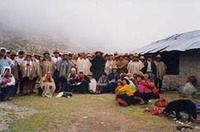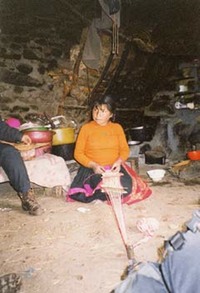The Q’eros and other Andean communities cultural heritage is thousands of years old, drawing from their diverse surroundings where three completely different levels according to their flora, fauna and other natural resources can be distinguished.
Agriculture
The indigenous peoples of the Andes have always tried to use as many microclimates as possible. Farming and cattle-herding resources were taken advantage of with the possibilities presented by the diversity of, on the one hand, the Amazon rainforest, and, on the other hand, the cold and barren highland plains. This is typical of the way the Q’eros’ Andean universe is built on different geographical layers, where work and play have their own specific locations. At the same time, they also practice their own version of sustainable development by trying to minimize the changes in climate, flora and fauna.
The Q’eros’ agricultural calendar shows the seasons when they descend to the yunga, the tropical zone.
- December and January: the planting of maize and chili
- March: weeding and earthing up of maize, also the planting of manioc, yacca, uncucha, and arrecacha.
- August: the gathering of wood and paca-paca (bamboo).
During these months, the Q’eros work in the hot zone. They take turns with their diverse activities involving fruit, coca leaves, pumpkins, seeds, and the gathering of medicinal plants.
Spirituality and Coca Leaf
In the Andean world, spirituality is closely linked to nature. The earth, the mountains, the rivers, the trees, the lakes, the caves and rocks are sacred. It is shown through Pachamama (Mother Earth) and the Apus (protective spirits of the mountains). In nature there is life everywhere, everything has power, and it is only up to man as how to use and take advantage of this power.
This explains why the Andean cultural, mythical and historical heroes have more magical and spiritual qualities than ordinary soldiers. The Andean soldiers have more to do with the power of wisdom than the power of guns.
Paqo in the Q’ero language means a priest. These pagos are experts in handling supernatural powers, powers which originate from Pachamama and the Cosmos. Paqos are required to know how to read and interpret coca leaves, each of which has countless possibilities. Each leaf has a unique form and message.
The priceless qualities of coca do not end there, however: its strengthening, nutritional and medicinal qualities form a balancing and uniting bond between the human and the super-human life of the Andes.
Nevertheless, since 1532 and the arrival of the Spanish, coca bush has been violently abused in order to humiliate the natives. This practice continues to have dire consequences on the social life of the people who use coca leaves in the traditional manner.
From Coca Leaf to Cocaine
During the Spanish conquest and the subsequent colonial era, coca leaf was an object of persecution. It had been declared “the archenemy of Christianity”, because the Catholic Church saw it as the greatest obstacle in their efforts to convert the natives.
In 1855, one of the fourteen alkaloids of the coca leaf was discovered in Europe, and this alkaloid came to be known as cocaine. It was considered a wonder drug in the medical circles, for both its anesthetizing and refreshing effects. In 1880, cocaine addiction as a phenomenon was recognized for the first time. Once again, coca leaf was viewed as satanic and outside the law, as it was blamed for causing drug addiction in the West. In reality, addiction to drugs in the Western metropolises has more to do with the breakdown in social and family relations, this breakdown in turn resulting from consumer mercantilism and radical individualism.
The Drug War and Globalization
In 2003, in the age of global economy (or capital dictatorship), drug traffic has reached the highest level. It is a powerful unofficial sector that rakes in up to $500 billion annually. Only arms trade can boast similar figures.
We are living at a time when drug capital can move freely. This capital is untouchable, protected by the banking secrecy laws of the international business community. The tax havens are conveniently located along the main drug trafficking routes: Panama and the Bahamas are centers of money laundering for the cocaine business, Hong Kong provides similar services to the Southeast Asia heroin business, and Gibraltar and Cyprus whitewash the profits made on the heroin of the Near East.
During the last 200 years, the cultivation of heroine has increased 20-fold, and of cocaine 50-fold. The big drug dealers are often respected businessmen who cannot be touched as long as they remain protected by the banking secrecy laws.
Ridiculously enough, the US continues blaming coca for these grave problems. The US continues its efforts to eradicate coca, while nothing is done to concentrate on the real problems, such as the international money laundering. The US war on drugs goes on, causing irreparable damage in both the Andes and the Amazon. Ironically, eradicating illegal drug plantations and building more prisons have not been successful in reducing neither cultivation nor drug abuse.
At the same time, the Q’ero priest, paqo, keeps chewing his sacred green coca leaf. Together with his people, the paqo blows the k’intu (the best three leaves) to the direction of the mountains, asking, predicting, foreseeing crises that cannot be avoided, as well as the next challenges…
Written by Juan Santos Rodriguez Huacanjulca, a Peruvian quechua, who is called chakaruna, a bridge-builder, among his people.



